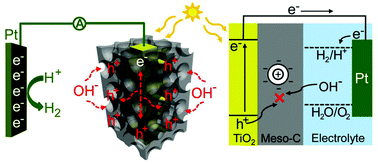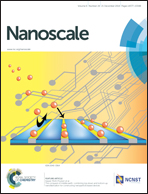Bias-free, solar-charged electric double-layer capacitors†
Abstract
The conversion of solar energy with simultaneous electric energy storage provides a promising means for optimizing energy utilization efficiency and reducing device volume. In this paper, a 3-dimensional mesoporous carbon coated branched TiO2 nanowire composite is rationally designed for direct conversion and storage of solar energy as electric double-layer capacitive energy. The 1-dimensional, crystalline TiO2 trunks serve as long light absorption and continuous charge transport pathways, and the high-density TiO2 branches can efficiently increase the contact area with the surface coated mesoporous carbon layers. In addition, the ordered and uniformed mesopores provide large pore sizes for electrolyte penetration, and a high surface area for charge absorption and storage. Under a 1-sun illumination and no external electric bias, this branched TiO2/mesoporous carbon composite exhibits specific capacitances of over 30 and 23.4 F g−1, at current densities of 0.1 and 0.5 A g−1, respectively. An excellent stability of >50 photocharging–electrical discharging cycles has also been demonstrated, suggesting the potential of further developing this hybrid material structure for simultaneous solar conversion and electric energy storage.


 Please wait while we load your content...
Please wait while we load your content...